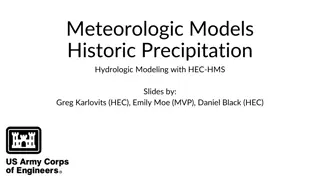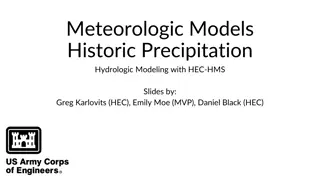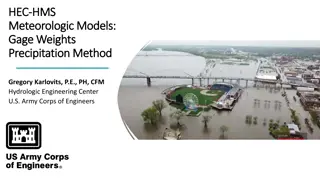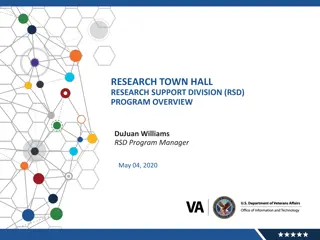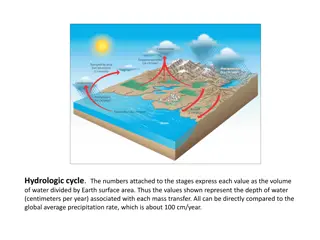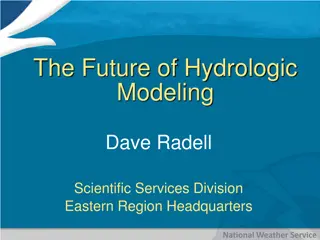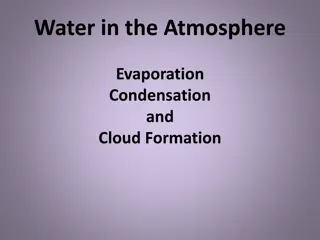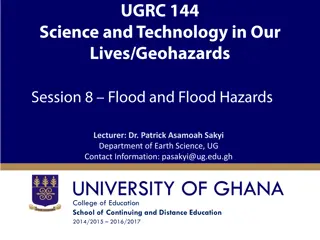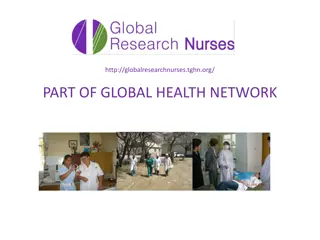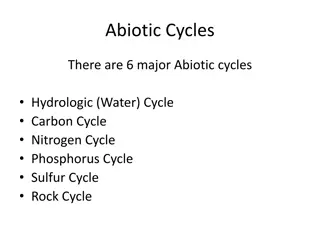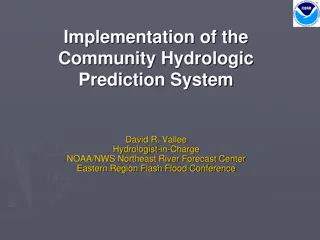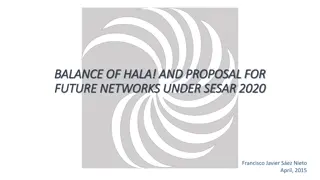Baikal Selenga Network (BaSeNet) - Hydrologic Research Program in PEEX
Baikal Selenga Network (BaSeNet) is a subprogram under PEEX focusing on studying waterborne matter transport in the Lake Baikal and Selenga River Drainage Basin. The program aims to quantify hydro-climatic impacts on large scales, utilizing a monitoring and modeling platform. Research objectives include exploring hydrological changes, regional comparisons, and developing predictive models for water quality and quantity. BaSeNet welcomes collaboration to enhance understanding of basin runoff and landscape changes.
Download Presentation

Please find below an Image/Link to download the presentation.
The content on the website is provided AS IS for your information and personal use only. It may not be sold, licensed, or shared on other websites without obtaining consent from the author. Download presentation by click this link. If you encounter any issues during the download, it is possible that the publisher has removed the file from their server.
E N D
Presentation Transcript
Baikal Selenga Network (BaSeNet) Baikal Selenga Network (BaSeNet) - PEEX Subprogram Baikal Selenga Network (BaSeNet) is a separate subprogram in PEEX acting according to MEMORANDUM OF COOPERATION (signed in Feb 2017) between Pan-Eurasian Experiment (PEEX) andBaSeNet. Program Director: Prof. Nikolay Kasimov, Lomonosov Moscow State University Russian Geographical Society BaSeNet is interested in investigating and quantifying the waterborne transport of matter under changing hydro-climatic conditions on large drainage basin scales. BaSeNet aims to utilize and further develop an already established unique monitoring and modeling platform within Lake Baikal and its main tributary Selenga River Drainage Basin which are considered as a large-scale field laboratory. The area represents a region of the Arctic Ocean catchment, which will also be used for cross-regional comparison with other parts of the world. Principal Investigator: Dr. Sergey Chalov, Lomonosov Moscow State University srchalov@geogr.msu.ru BaSeNet is open to all interested parties and scientists to work together for the integrated hydrologic-hydrogeologic-geochemical region in the extensive Baikal Selenga drainage basin. Read more: About BaSeNet Specific objectives & Research questions Main publications Collaborators
Baikal Selenga Network (BaSeNet) - PEEX Subprogram About BaSeNet To promote and further develop hydrologic-hydrogeologic-geochemical research in PEEX BaSeNet is : Program Director: Prof. Nikolay Kasimov, Lomonosov Moscow State University Russian Geographical Society 1. developing an adaptive regional characterization approach that enables use of the extensive Baikal Selenga drainage basin as a large-scale field laboratory for measuring: representative hydrological and hydrogeochemical characteristics of the individual and the coupled groundwater and surface water systems solute, suspension and bedload transport over control planes at multiple locations within the basin changes in flow and transport characteristics during hydrological (precipitation) events, and between hydrological seasons. Principal Investigator: Dr. Sergey Chalov, Lomonosov Moscow State University (srchalov@geogr.msu.ru) 2. using the Baikal Selenga drainage basin results in inter-regional comparison studies with consistently investigated other drainage basins in different world parts. The comparison aim is to identify similarities and systematic differences between large basin characteristics, hydrological responses to climate change, and tracer-pollutant spreading behavior (spatiotemporal variability and change trends) across different main drainage basins of the world. In this comparative context, the Baikal Selenga drainage basin represents a sparsely populated and as of yet largely unmonitored and unregulated river basin with discontinuous permafrost, discharging through Lake Baikal and its downstream river network into the Arctic Ocean.
Baikal Selenga Network (BaSeNet) - PEEX Subprogram Specific objectives & Research questions to summarize our current state of knowledge regarding fluxes and forms of elements; to continue collaborations between researchers who study physical processes of sediment movement, chemical discharges, and hydrological processes; to better produce/refine models of physical and chemical processes for flux analysis within the catchment Basin-wide perspective on advanced water budget, to produce advanced water budgets and predictive models of water quality, with emphasis on establishing uniform protocols of data collection methodologies, and establishing protocols for sharing among research groups Implications of changes in the landscape for influencing basin runoff: water quantity and quality modeling and monitoring, with tributary system studies to further (precisely) refine sources of heavy metal inputs, and identify local catchment variations Big picture ; to constrain predictions at basin-scale, with emphasis that the system, in its current configuration, remains un-dammed, and that this is about to change. Emphasizing the need to better understand the Selenga system in terms of the functions of various processes, such as catchment-scale sediment erosion and transport models Large-scale transport phenomena; can we track contaminants from sources in the upstream mining, using both geophysical processes and chemical fingerprinting? This dovetails nicely with a source to sink style study, specifically targeting grain size (washload versus bedload), and provides a basis for evaluating sediment residence time in a dispersal systems, which is a BIG topic in basin research A catchment-wideflux analysis could be utilized to evaluate/predictwater quality: what are the pollutants? What are the necessary stateof the art treatment processes? Is it possibleto utilize a particular tracer (e.g., arsenic) to evaluate fate of chemicaltransportvariability in timeand space (e.g., year-to-year and over basin scale); such a paper/studycould be a prime example of bringing our work together Program Director: Prof. Nikolay Kasimov, Lomonosov Moscow State University Russian Geographical Society Principal Investigator: Dr. Sergey Chalov, Lomonosov Moscow State University (srchalov@geogr.msu.ru)
Baikal Selenga Network (BaSeNet) - PEEX Subprogram Main publications THORSLUND, J., JARSJ , J., BELOZEROVA, E.V. AND CHALOV, S.R. (2012) Assessment of the gold mining impact on riverine heavy metal transport in a sparsely monitored region: the upper Lake Baikal Basin case. J. Environ. Monit., 14, 2780-2792 KARTHE, D.; HOFMANN, J.; IBISCH, R.; HELDT , S,; WESTPHAL, K.; MENZEL, L.; AVLYUSH, S. & MALSY, M. (2015): Science-Based IWRM Implementation in a Data-Scarce Central Asian Region: Experiences from a Research and Development Project in the Kharaa River Basin, Mongolia. Water 7(7): 3486- 3514. KARTHE, D.; MALSY, M.; KOPP, B.; MINDERLEIN, S. & HULSMANN, L. (2013): Assessing water availability and its drivers in the context of an integrated water resources management (IWRM): a case study from the Kharaa River Basin, MONGOLIA. GEOOKO 34(1-2):5-26. MALSY, M.; AUS DER BEEK, T.; FLORKE, M. (2015): Evaluation of large-scale precipitation data sets for water resources modelling in Central Asia. Environmental Earth Sciences 73(2): 787-799. MALSY, M.; HEINEN, M.; AUS DER BEEK, T. & FLORKE, M. (2013): Water recourses and socio-economic development in a water scarce region on the example of Mongolia. GeoOko 34(1-2):27-49. KARTHE, D.; CHALOV, S.; THEURING, P. & BELOZEROVA, E. (2013): Integration of Meso- and Macroscale Approaches for Water Resources Monitoring and Management in the Baikal-Selenga-Basin. In: Chifflard, P.; Cyffka, B.; Karthe, D. & Wetzel, K.-F. (2013): Beitr ge zum 44. Jahrestreffen des Arbeitskreises Hydrologie, 90-94. Augsburg: Geographica Augustana. CHALOV SERGEY R., JARSJ JERKER, KASIMOV N., ROMANCHENKO A., PIETRON JAN, THORSLUND J., BELOZEROVA E. (2015) Spatio-temporal variation of sediment transport in the Selenga River Basin, Mongolia and Russia // Environmental Earth Sciences 73(2): 663-680 Program Director: Prof. Nikolay Kasimov, Lomonosov Moscow State University Russian Geographical Society Principal Investigator: Dr. Sergey Chalov, Lomonosov Moscow State University (srchalov@geogr.msu.ru)
The BaSeNet collaborators: Baikal Selenga Network (BaSeNet) - PEEX Subprogram Lomonosov Moscow State University, Russia Department Aquatic Ecosystem Analysis and Management, Helmholtz Centre for Environmental Research, Germany Institute of Geography Mongolian Academy of Sciences, Ulaanbaatar, Mongolia Department of Earth Science, Rice University, Houston, TX, USA Department of Physical Geography and Quaternary Geology, Stockholm University, Sweden A.N. Severtsov Institute of Ecology and Evolution, Russian Academy of Sciences, Moscow, Russia Baikal Institute of Nature Management, Ulan Ude, Russia Institute of Geography, Irkustsk, Russia Department of Soil and Hydro-Geography, Faculty of Geography, Marburg University, Germany Program Director: Prof. Nikolay Kasimov, Lomonosov Moscow State University Russian Geographical Society Principal Investigator: Dr. Sergey Chalov, Lomonosov Moscow State University srchalov@geogr.msu.ru) BaSeNet is open to all interested parties and scientists to work together for the integrated hydrologic-hydrogeologic-geochemical region in the extensive Baikal Selenga drainage basin.






